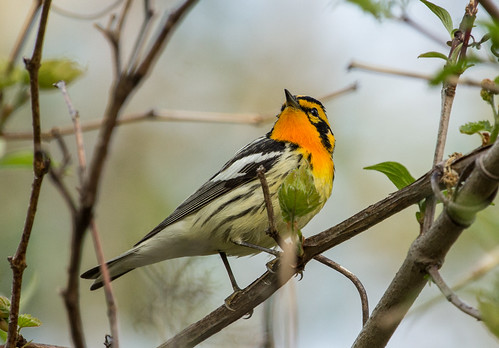 |
| Canada Warbler (this one is being held by a bird bander just before release) |
This spring, during the peak of warbler migration, two windows on my house killed three birds. I found one poor Blackburnian Warbler under the big bay window that had already been covered with special bird-protecting tape—we’re not 100 percent certain it was killed at that window or one upstairs, but based on the bird's position on the ground, I suspect the bay window. And a Canada Warbler was killed at the tiniest window in the house, our kitchen window. A Merlin must have been chasing it or something, because that one made a direct hit, head on at top speed. The tips of both the upper and lower bills were broken. The lower bill was also broken at the base where it met the face on the right side, and the upper bill was broken where it met the face on the left side—blood was dripping from that nostril.
 |
| These two birds died on May 18 and 19. |
Both these deaths were horrifying to me. Warblers are such gorgeous birds, and so very tiny. Both these species average little more than a third of an ounce. Blackburnian Warblers winter in Central and northern South America, and Canada Warblers virtually all winter in northern South America.
The straight-line distance from the Panama Canal to Duluth is 2707 miles—the bare minimum each of those birds flew, entirely on his own power—wingbeat after wingbeat for days or weeks, stopping for food here and there, after surviving an entire fall migration down there in the first place, and a full winter competing with hundreds of tropical birds and staying clear of snakes and lizards and an abundance of other predators. They survived all this for nothing more than to smash into a sheet of glass when they were so very close to their final destination, where they could finally fulfill the hormonal imperative that sent them on the long journey in the first place, to raise young.
 |
| How a Blackburnian Warbler SHOULD look |
Any bird death at a window is an obscene waste, but losing tropical migrants seems somehow even more tragic, though when I found a dead Pine Siskin under the same tiny kitchen window I felt just as sad. That window will be first to get some bird-safe collision protection this summer, but we’re also adding something to every window on our house, including the many windows that so far don’t seem to have ever killed a bird during all the 34 years we’ve lived here. Even a single death is too many.
Those were the fatalities, but our windows knocked a few other birds out, too. One Swainson’s Thrush hit the window above our garage door. We hadn’t had a collision with that window in years, but apparently it needs some bird-safe protection against collisions, too. The thrush was stunned for several minutes.
 |
| Swainson's Thrush, still stunned, in a shoebox lined with paper towels. Wadding some of it provides some support before the bird can balance on its own. |
My normal technique when a songbird hits a window is to place it in a shoebox, with paper towels on the bottom to give it something textured to grip, and place it in a cool place out of sunlight, checking on it every five minutes or so, but only outdoors, during daylight. The darkness keeps the bird quiet so if it does come out of its stunned condition it won’t panic and reinjure itself. I of course only open the box outdoors in case it has come out of its daze. I feel better about the release if the bird has some time to notice its surroundings and get its bearings before it flies off, so when the bird seems to have good balance and be a little alert, I hold it in my hand to make sure it's gripping evenly on both feet, and then move it to a branch or twig that I hold in my hand.
The thrush stayed in the box for 10 or 15 minutes. When it started looking around somewhat alertly when I opened the box, I carried it in my hand to the center of the yard, away from the house. I took some photos—first, some close-ups in my hand and then on a branch. It took several minutes to look around and get its bearings, and then suddenly took off. Sadly, even when they do take off, they only have a 50 percent chance of survival. Subdural hematomas and other invisible injuries take a significant toll.
 |
| At this point it's perched on a wide twig, getting its bearings. |
Some Swainson's Thrushes winter from Mexico through Central America, but most spend the season in South America. Again, this bird flew a long, long way just to hit a window so close to its destination, but at least this one has a good chance of surviving.
Even though we can’t prevent all of them, next time I’ll talk about what we can do to reduce the chance of collisions at our windows.





